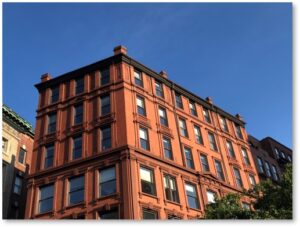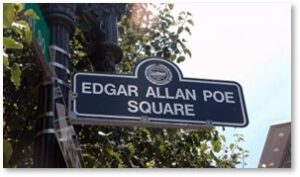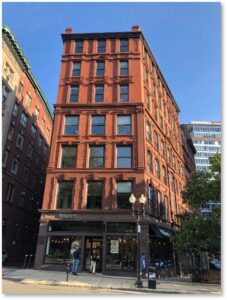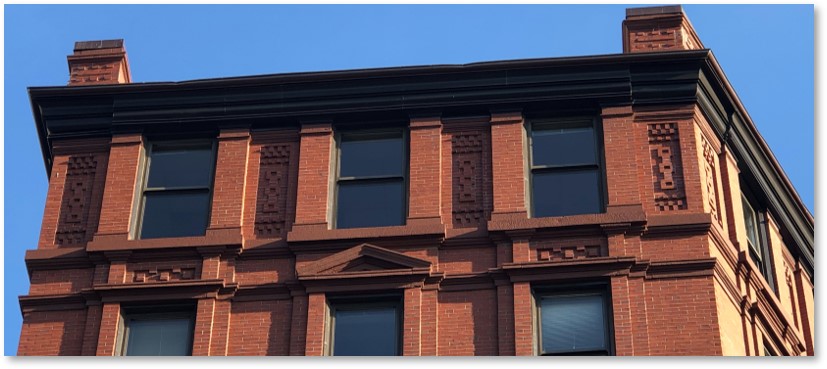This is the last of four posts about the block of Boylston Street between Tremont Street and Charles Street known as Piano Row. It held a lot more to talk about than I had originally expected. Today’s post picks up after the Steinert and Son piano show room and reaches the end of the block at Poe Square.
Carver Street
Carver Street today is a short dark alley lined with Dumpsters that roughly parallels Boylston Place. It starts at Boylston Street and ends at the State Transportation Building. In 1814 it stretched across what is now Stuart Street and then south to Pleasant Street. All that changed first in a burst of road development and urban renewal in the sixties and second when the Transportation Building went up in 1983.
Few would remember Carver Street today were it not for its most famous resident. Little Edgar Poe was born on the part of Carver Street that disappeared, along with all of Pleasant Street, when South Charles Street was created.
No one noticed or cared that Boston had wiped out the birthplace of one of America’s most famous authors along with the house and most of the street on which he had lived. More on this later.
176 Boylston Street
On the west side of Carver Street, we come to 176 Boylston Street. This large brick structure presents a narrow face to Boston Common but extends well down South Charles Street. It once housed a florist that had been there since 1937 and Biltmore Luggage had occupied it before that for over 70 years. That dates the building to at least 1867. Unlike many commercial buildings of that period, it does not incorporate a name into the façade, which hinders research.
The building itself is one of those structures that gives Boston its red-brick character while drawing no attention to itself. Architecturally it offers a mish-mish of different styles.
176 Boylston is seven stories tall with two chimneys on the Boylston Street corners. Each floor treats its window surrounds differently and tops them with pediments in a variety of styles. Some panel-brick work decorates the corners and the spaces between pilasters on the top floor as well as the chimneys.
The Sunny West Face
The building’s west face, along South Charles Street, looks bright and warm on a sunny day. Midway down its length, the third and fourth floors have windows that appear larger because of the brickwork surrounding them and the elaborate pediments above.
 The bottom floor is currently occupied by Boloco, a fast-casual seller of burritos and other Mexican food. Boloco opened up the building’s ground floor with panoramic windows that give a clear view of Boston Common.
The bottom floor is currently occupied by Boloco, a fast-casual seller of burritos and other Mexican food. Boloco opened up the building’s ground floor with panoramic windows that give a clear view of Boston Common.
On its west side, 176 Boylston Street was the location of the venerable Jack’s Joke Shop, purveyors of sleight-of-hand tricks, whoopie cushions and rubber chickens for decades. Many Bostonians remember Jack’s Joke Shop fondly.
Current occupants include Old Towne Trolley sightseeing tours and L.J. Peretti Co., a cigar store.
Poe Square
The triangle of land at the corner of Boylston and South Charles Streets is now named Poe Square, which finally recognizes the birthplace of Edgar Allan Poe. Born on January 18, 1809, to David and Elizabeth Poe, Edgar lived in the city for a short time His parents were itinerant actors at the Boston Theater and moved from the city before little Edgar was two years old.
 He returned in 1827 when he joined the U.S. Army and was stationed at Fort Independence on Castle Island. That same year he gave a reading of his first book, “Tamerlane and Other Poems,” that Boston’s critics, many of them the Transcendentalist authors, panned. That started a love-hate relationship between Mr. Poe and the City of Boston.
He returned in 1827 when he joined the U.S. Army and was stationed at Fort Independence on Castle Island. That same year he gave a reading of his first book, “Tamerlane and Other Poems,” that Boston’s critics, many of them the Transcendentalist authors, panned. That started a love-hate relationship between Mr. Poe and the City of Boston.
He called Bostonians “very dull people” and “Frogpondians.” In return, the City of Boston chose to ignore him. Boston might have its statues of Edward Everett Hale, Samuel Eliot Morrison, William Lloyd Garrison, and even Mrs. Mallard with her Ducklings but it literally demolished locations that might have memorialized Edgar Allan Poe. Then it dusted its hands and moved on.
Poe Returning to Boston
That neglect changed during the 2009 bicentennial when Boston renamed this small triangle of land as Edgar Allan Poe Square. Easy peasy. Put up a sign and you’re done. (The plaque on 176 Boylston was placed there by a private citizen, not the city.) The square holds outdoor dining for Boloco along with tree-shaded benches.
Only in 2014 did an actual statue of Edgar Allan Poe take its place on his eponymous square. That was financed, typically, by the Edgar Allan Poe Foundation of Boston, Inc.– not the city.
In an irony Mr. Poe would have appreciated, “Poe Returning to Boston,” by Stefanie Rocknack turned out to be one of Boston’s best memorials. It has all the movement, drama, and mystery so lacking in earlier, inert statues of Dead White Men, whether authors, politicians, or philanthropists. It gives us a visual representation of Edgar Allan Poe’s belief that art should entertain and move, not argue causes.
Edgar Allan Poe strides energetically along with his hair and coat flying out behind him.. His raven flies by his side, wings outstretched, talons wide, and beak gaping. His stuffed suitcase spills open and the Telltale Heart falls out. Along with it drop manuscripts and pages of his prolific writing, which scatters across Poe Square all the way to Boylston Street.
The End of Piano Row
Poe Square is where Piano Row ends and, with it, this series of blog posts. I hope you have enjoyed learning more about this short block with its long and varied musical history.
Theater District and Piano Row
 The Buildings of Piano Row: Part 1
The Buildings of Piano Row: Part 1- Piano Row Buildings: Part 2
- The Buildings of Piano Row: Part 3 and Steinert Theater
- Boylston Place: Education, Art, Football
- The Boston Young Men’s Christian Union
- The Emerson Colonial Theater: Gilded Glory Returns
- LaGrange Street: Connecting Centuries
- The Cutler Majestic: A Gilded Renovation
- The Little Building’s Arcade and Murals




There used to be a piano bar area located here in the 1980’s. What was the name?